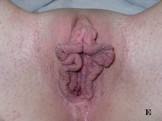Wednesday, November 5, 2008
14269
A Retrospective Analysis of Elective Labia Minora Reduction with Regard to Operative Technique, Outcomes and Patient Demographics
Purpose: This retrospective study was designed to evaluate the author's experience performing labia minora reduction over the last five years.
Methods: The operations were evaluated by chart review, and the results were evaluated by before and after photo review paired with patient response to a questionnaire. Factors assessed included patients' reasons for the surgery, patient satisfaction with the procedure, operation duration and location, operative technique and outcomes. The study was also designed to evaluate typical patterns of labial hypertrophy and outcome based on starting classification.
Results: Over the last five years the author has performed 118 labia minora reductions. The majority of these operations were performed in the last three years as the procedure has grown in popularity. The author currently performs 4-6 procedures per month. 13% were performed in combination with vaginoplasty to tighten the vaginal introitus. 24% were performed in combination with other surgeries such as bladder suspension (dual surgery with a urogynecologist), abdominoplasty and breast augmentation. Patient ages ranged from 16 to 57. Reasons given for undergoing the surgery included irritation or discomfort with activity or intercourse and embarrassment at the appearance of the labia. 100% of patients who responded to the questionnaire stated that they were happy that they had undergone surgery.
Initially the surgeries were uniformly performed in surgery centers with either general anesthesia or deep sedation. In the last two years, more than half of isolated labiaplasties have been performed in a well-equipped clinic procedure room with local anesthetic and mild or no oral sedation. Operative time is routinely under 1 hour. Post-op care includes 5 days of antibiotics and two weeks of topical Bacitracin ointment as well as sitz baths. Vaseline to the operative site is then recommended for an additional two weeks. The patients are told to refrain from intercourse for 1 month post-op.
Labia Minora hypertrophy can be classified into three main sub-types: central (fig A, B), diffuse (fig C,D), and anterior (fig E, F). The majority of observed hypertrophy follows a central pattern with the excess tissue located equidistant from the anterior and posterior extent of the labia. All sub-types were treated with a similar "V" wedge central excision with occasional anterior perpendicular extensions to eliminate multiple folds in the tissue. No clitoral unhooding procedures were performed. Results were most favorable with the central hypertrophy pattern (Fig. A, B), but all patterns responded fairly well to the basic operation (see figs A-F).
Complications were classified as minor (no intervention necessary), medium (minor intervention required or prolonged recovery) and major (serious medical intervention required or chronic patient complaints). There were no major complications. Minor complications included local irritation lasting longer than 1 month and suture breakage that was allowed to heal secondarily. Medium complications included infection requiring antibiotics, prolonged irritation (up to three months) or poor scar or asymmetry requiring minor surgical correction.
Infections were rare and limited to yeast infections from peri-operative antibiotics and occasional stitch abscesses from deep vicryl sutures. 7 revisions were performed to correct asymmetry, persistent hypertrophy or uneven scars, 5 of which were performed in the clinic. The longest reported chronic irritation and pain with intercourse was 4 months in 1 patient and three months in 4 patients. This seemed to correspond with the duration of the deep vicryl sutures.
Conclusions: Surgical reduction of the labia minora is a quick and well tolerated procedure that can frequently be performed in a well equipped clinic or office procedure room. Complications are rare and correctible. Even patients with complications express satisfaction with the procedure






